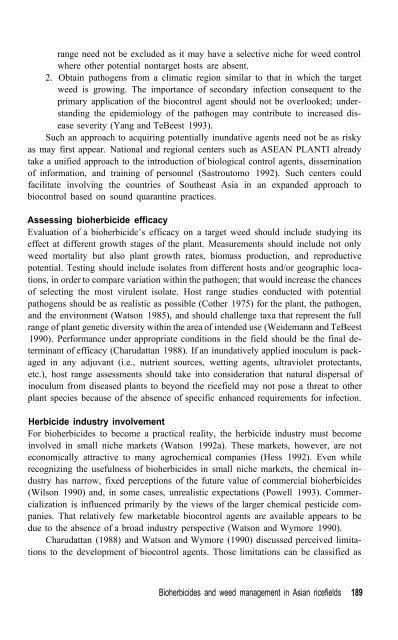HERBICIDES in Asian rice - IRRI books - International Rice ...
HERBICIDES in Asian rice - IRRI books - International Rice ...
HERBICIDES in Asian rice - IRRI books - International Rice ...
Create successful ePaper yourself
Turn your PDF publications into a flip-book with our unique Google optimized e-Paper software.
ange need not be excluded as it may have a selective niche for weed control<br />
where other potential nontarget hosts are absent.<br />
2. Obta<strong>in</strong> pathogens from a climatic region similar to that <strong>in</strong> which the target<br />
weed is grow<strong>in</strong>g. The importance of secondary <strong>in</strong>fection consequent to the<br />
primary application of the biocontrol agent should not be overlooked; understand<strong>in</strong>g<br />
the epidemiology of the pathogen may contribute to <strong>in</strong>creased disease<br />
severity (Yang and TeBeest 1993).<br />
Such an approach to acquir<strong>in</strong>g potentially <strong>in</strong>undative agents need not be as risky<br />
as may first appear. National and regional centers such as ASEAN PLANTI already<br />
take a unified approach to the <strong>in</strong>troduction of biological control agents, dissem<strong>in</strong>ation<br />
of <strong>in</strong>formation, and tra<strong>in</strong><strong>in</strong>g of personnel (Sastroutomo 1992). Such centers could<br />
facilitate <strong>in</strong>volv<strong>in</strong>g the countries of Southeast Asia <strong>in</strong> an expanded approach to<br />
biocontrol based on sound quarant<strong>in</strong>e practices.<br />
Assess<strong>in</strong>g bioherbicide efficacy<br />
Evaluation of a bioherbicide’s efficacy on a target weed should <strong>in</strong>clude study<strong>in</strong>g its<br />
effect at different growth stages of the plant. Measurements should <strong>in</strong>clude not only<br />
weed mortality but also plant growth rates, biomass production, and reproductive<br />
potential. Test<strong>in</strong>g should <strong>in</strong>clude isolates from different hosts and/or geographic locations,<br />
<strong>in</strong> order to compare variation with<strong>in</strong> the pathogen; that would <strong>in</strong>crease the chances<br />
of select<strong>in</strong>g the most virulent isolate. Host range studies conducted with potential<br />
pathogens should be as realistic as possible (Cother 1975) for the plant, the pathogen,<br />
and the environment (Watson 1985), and should challenge taxa that represent the full<br />
range of plant genetic diversity with<strong>in</strong> the area of <strong>in</strong>tended use (Weidemann and TeBeest<br />
1990). Performance under appropriate conditions <strong>in</strong> the field should be the f<strong>in</strong>al determ<strong>in</strong>ant<br />
of efficacy (Charudattan 1988). If an <strong>in</strong>undatively applied <strong>in</strong>oculum is packaged<br />
<strong>in</strong> any adjuvant (i.e., nutrient sources, wett<strong>in</strong>g agents, ultraviolet protectants,<br />
etc.), host range assessments should take <strong>in</strong>to consideration that natural dispersal of<br />
<strong>in</strong>oculum from diseased plants to beyond the <strong>rice</strong>field may not pose a threat to other<br />
plant species because of the absence of specific enhanced requirements for <strong>in</strong>fection.<br />
Herbicide <strong>in</strong>dustry <strong>in</strong>volvement<br />
For bioherbicides to become a practical reality, the herbicide <strong>in</strong>dustry must become<br />
<strong>in</strong>volved <strong>in</strong> small niche markets (Watson 1992a). These markets, however, are not<br />
economically attractive to many agrochemical companies (Hess 1992). Even while<br />
recogniz<strong>in</strong>g the usefulness of bioherbicides <strong>in</strong> small niche markets, the chemical <strong>in</strong>dustry<br />
has narrow, fixed perceptions of the future value of commercial bioherbicides<br />
(Wilson 1990) and, <strong>in</strong> some cases, unrealistic expectations (Powell 1993). Commercialization<br />
is <strong>in</strong>fluenced primarily by the views of the larger chemical pesticide companies.<br />
That relatively few marketable biocontrol agents are available appears to be<br />
due to the absence of a broad <strong>in</strong>dustry perspective (Watson and Wymore 1990).<br />
Charudattan (1988) and Watson and Wymore (1990) discussed perceived limitations<br />
to the development of biocontrol agents. Those limitations can be classified as<br />
Bioherbicides and weed management <strong>in</strong> <strong>Asian</strong> <strong>rice</strong>fields 189

















